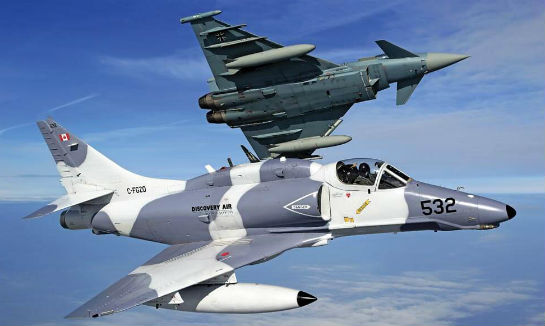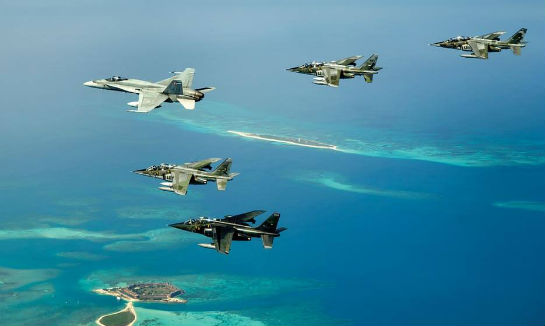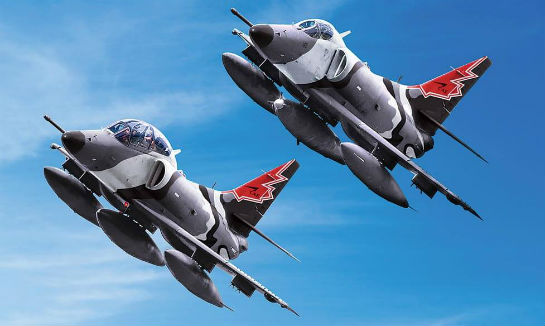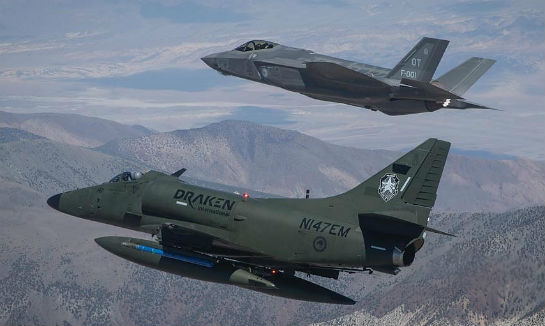Estimated reading time 12 minutes, 6 seconds.

Red air is a market on the rise, estimated by some to be worth billions over the next decade. Since 2005, Discovery Air Defence has provided a combination of fast fighter jets and business jets to simulate hostile threats for Canadian fighter pilots, naval crews and land forces. Dr. Stefan Petersen Photo
When Canadian fighter jets, transport aircraft and tactical helicopters gather with American, British and French counterparts over the skies of 4 Wing in Cold Lake, Alta., in June for Exercise Maple Flag, their adversary will include a team of Dornier Alpha jets flown by former Royal Canadian Air Force (RCAF) pilots.
The modified jets are part of a larger fleet of fighter and business aircraft operated by Montreal-based Discovery Air Defence, formerly Top Aces, under an interim contract to provide aggressor, or red air, services to the Canadian Armed Forces (CAF). And where the CF-188 Hornets go, the Alphas are often not far behind.
From daily training at home to multinational exercises abroad, contracted aggressor air has become vital to how Canada trains and prepares its pilots. The Discovery Air Defence (DA Defence) fleets are part of the monthly routine at the tactical fighter squadrons, and deploy with them as required to exercises such as the recently completed Puma Strike in Key West, Fla.
Red air is a market on the rise, estimated by some to be worth billions over the next decade. With defence budgets stagnant or in decline, most NATO militaries are looking for efficiencies wherever they can. Privately contracted aggressor air services offer an alternative to the wear and tear on already taxed combat fighter fleets that are costly to operate and would be better used to ensure pilot readiness, rather than role playing adversaries, towing targets, emulating attacks on ships, or training joint terminal attack controllers (JTAC). Call it a tipping point, but the number of fourth and fifth generation fighters entering service globally means militaries from Australia to Europe, the U.S., U.K., and the Middle East are assessing future red air needs.
“The training demands on pilots are getting more complex. It’s not just about flying aeroplane[s]—you are a sensor system manager. [While] a lot of that might be migrating to simulation, there is still lots of flying being done,” Garry Venman, DA Defence’s vice president of business development, said in a recent interview with Jane’s International Defence Review. “If you need a sparring partner, contractors can do this to a very high standard for a fraction of the price.”

A CF-188 Hornet is accompanied by four DA Defence Alpha Jets during an international training exercise over Fort Jefferson in the lower Florida Keys. Cpl Pierre Habib Photo
Moving from a military-provided service to a privately delivered model has its critics. The defence industry has been managing training schools and simulation centres for years, but aggressor air is “a different ballgame,” said Garrick Ngai, DA Defence’s director of marketing, and may require a cultural shift among decision-makers.
Many countries, he said, are still grappling with the mechanics of contracted red air services. “This involves commercial aircraft operating with military aircraft, and you are touching things like airworthiness, military authorities, civil authorities—a lot of legalities that involve multiple parties.”
That makes Canada’s Contracted Airborne Training Services (CATS) program an interesting model for many allies. Beginning in the early 2000s, the CAF was among the first in NATO to adopt contracted airborne services for army, navy and air force training, albeit on an interim basis. But the agreements with Transport Canada and the Department of National Defence that underpin the program provide an oversight framework that could be applied elsewhere.
“The Canadian model is highly regarded by allies, especially NATO allies in Europe,” Ngai said.
Since 2005, under a series of standing offers, DA Defence has provided a combination of fast fighter jets and business jets, stationed at bases in Esquimalt, Cold Lake, Bagotville, and Halifax, to deliver simulation of hostile threats for fighter pilots, naval crews and land forces, including JTAC training; target towing to train radar, electro-optical, and infrared-guided weapons system operators; and electronic warfare training for aircrews, land forces, aerospace weapons controllers, and navy frigates.
“It’s been good for the army and the navy, but it’s been even better for the air force because we preserve very costly F-18 hours,” said Col Paul Dittmann, the RCAF’s director of air simulation and training. An hour of CF-188 flying costs approximately $30,000.
Western air forces, he said, want a blend of live, virtual, and constructive training that can be delivered with a lower fidelity platform able to emulate various systems that will challenge pilots, but “at a fraction of the cost and with repeatability and a lot higher operational readiness output. From an air force perspective, we want to expand on this.”
In August 2015, the Forces issued a request for proposals that would make CATS a permanent fixture for at least the next 10 years, with options for renewals that could extend the service to 2031. The new contract, estimated at up to $1.5 billion, includes the platforms, air crews, maintenance and facilities, as well as project management.
When the RFP closed on Feb. 16, Public Services and Procurement Canada had received three bids. DA Defence, the incumbent, and CAE Canada promptly confirmed their bids.
The third bidder has remained silent. Both Kelowna-based KF Aerospace, which provides the RCAF’s Contracted Flying Training and Support, the first phase in pilot development, and Nevada-based Tactical Air Support, told Skies they did not submit bids.
Bryan Akerstream, director of business development for KF Aerospace, said it wasn’t the right fit for the company and questioned the shelf life of CATS as the RCAF continues to advance its Future Air Crew Training program. It is better “suited to the incumbent or someone who has….airplanes already modified to do the work,” he said. “It became a non-competitive environment for us to dip our foot into.”
Gerry Gallop, senior vice president for Tactical Air Support, said that while the company operates four former Canadian CF-5Ds and “purchased the remainder of the CF-5 parts from the DND a few years ago,” it did not submit a proposal.
Airborne Tactical Advantage Company (ATAC), a Virginia-based business recently acquired by Textron Advanced Aviation Training that has 20 years of aggressor air experience with both the U.S. Marine Corps and navy and international clients, did not respond to requests for confirmation.
The CATS contract is expected to be awarded before the end of 2016.
The program and the contenders
Although CATS will transition from an interim to a formalized program, changes to the core capabilities are minimal, Dittmann said. The Forces are requesting enhanced JTAC capabilities that include night vision imaging systems, electro-optical targeting and bomb delivery. In addition, the aircraft must carry a variety of pods—multi-band jammers, threat replicators, tracking equipment—that will be provided and maintained by the CAF.
As for the aircraft themselves, CATS calls for a multi-role combat support fighter (MCSF) able to operate from a 6,000-foot runway, attain a minimum airspeed of 480 knots at 1,000 feet and Mach 0.85 at any altitude, function within a G range of -2 to +5, and operate up to a service ceiling of flight level 350; and a medium endurance aircraft (MEA) with a minimum airspeed of 300 knots at 1,000 feet and Mach 0.7 at flight level 300, a G range of -1 to +2, and a service ceiling of flight level 350. The RFP does not specify the number of aircraft required, but the contractor will be expected to support up to eight concurrent MCSF taskings and up to two concurrent MEA taskings.
In response to the government’s RFP, Montreal-based CAE formed a partnership with Draken International of Lakeland, Fla., operator of one of the largest combat aggressor air fleets. The two companies have created a Canadian joint venture, to be managed by CAE, and are proposing a fleet of Douglas A-4 Skyhawks, newly kitted with modern avionics and APG-66 radar, and a smaller fleet of Lear 35 business jets. They are also proposing to include a cadre of pilots with recent experience training against F-22 Raptors and F-35 Joint Strike Fighters.

Montreal-based CAE and Draken International of Lakeland, Fla., have teamed up to offer Canada a fleet of updated Douglas A-4 Skyhawks in the aggressor air role. CAE/Draken Image
Though Draken brings the red air pedigree, CAE said the bid is Canadian. “Those aircraft will be registered in Canada and operated and maintained by CAE in Canada,” said Mike Greenley, vice president and general manager. “Our pilots will be Canadian, our maintainers will be Canadian.” CAE will also lean on a national supply chain to support the program.
Recent upgrades to the Skyhawks mean few modifications will be required to meet the contract requirements; in fact, Greenley said the high-fidelity systems in the A-4 will likely exceed what the RCAF is seeking.
“There are some basic requirements that you might be able to meet with a training-type jet, but because we are going with a full fighter jet, we exceed a lot of those requirements,” he commented. “Some people will be bid compliant with a radar emulator but we will be more capable by delivering a full radar into the aircraft, which will give our pilots more ability to play an effective aggressor role.”
CAE is also aiming to leverage the corporate knowledge it gained with the recent acquisition of the NATO Flying Training in Canada (NFTC) program from Bombardier in October 2015, which supports the CT-156 Harvard and the CT-155 Hawk lead-in fighter trainers for the RCAF.
“We fully maintain and operate those fleets at very high levels of readiness,” Greenley explained, “so my crews are well positioned to step up to a full-level fighter jet and be able to operate that in the Canadian landscape.”

Draken International provided A-4 Skyhawks (bottom) to operate as adversary aircraft during F-35A Lightning II operational testing for the Royal Netherlands Air Force in August 2015. Frank Crebas Photo
As the incumbent, DA Defence doesn’t anticipate significant changes to what it currently provides. It brings a decade of experience flying the red air mission profiles of the CAF and has 55,000 hours of airborne training services to back it up. And its Canadian credentials are well established.
But the company is investing nonetheless, seeking a fleet of supersonic F-16 Falcons to counter the capabilities of F-22s, F-35s, Typhoons, and Rafales.
“We’ve heard from different customers that the F-16 is the most ideal solution for their red air needs,” Ngai said, adding that DA Defence would be incorporating advanced radar and electronic attack capabilities into its aircraft to “really challenge fifth generation fleets,” and investing in enhancements such as NTISR (non-traditional ISR) and networkability.
“It’s an exciting time for contracted aggressor air services worldwide,” continued Ngai. “As more countries adopt the model and as the market matures, the contractor’s role will evolve and expand. With our experience, capabilities and people, I’m very confident in our market leadership and success.”
Although CATS is the current priority, both DA Defence and CAE are looking beyond Canada to international markets. The government made export of the training service a key requirement of the RFP, and both say they are well positioned to deliver.
“There are a half dozen locations around the world that we have identified that are looking at these programs,” said Greenley. CAE already exports training and simulation systems to many, he added. As part of its value proposition to Canada, the company is proposing a research and development program to develop aggressor threat solutions that could also be exported.
“You can’t live-fly all of the threats that [modern] fighters will have to fly against; you need that live, virtual, constructive next-generation solution to create the effective scenarios to train against,” he concluded.
DA Defence already has a foothold in Europe and is looking to grow. The company began providing a program similar to CATS to the German Armed Forces in January 2014, operating the same McDonnell Douglas A-4N Skyhawks as its predecessor but increasing their safety, reliability and availability, said Ngai.
Located in Wittmund near the North Sea, DA Defence believes it is strategically positioned to expand as other European countries encounter its red air forces in multinational training exercises.
Winning over cautious militaries will require a proven record of red air performance, something both Discovery Air Defence and CAE/Draken bring in spades. But having the Contracted Airborne Training Services program framework to fall back on could assuage any lingering fears.

